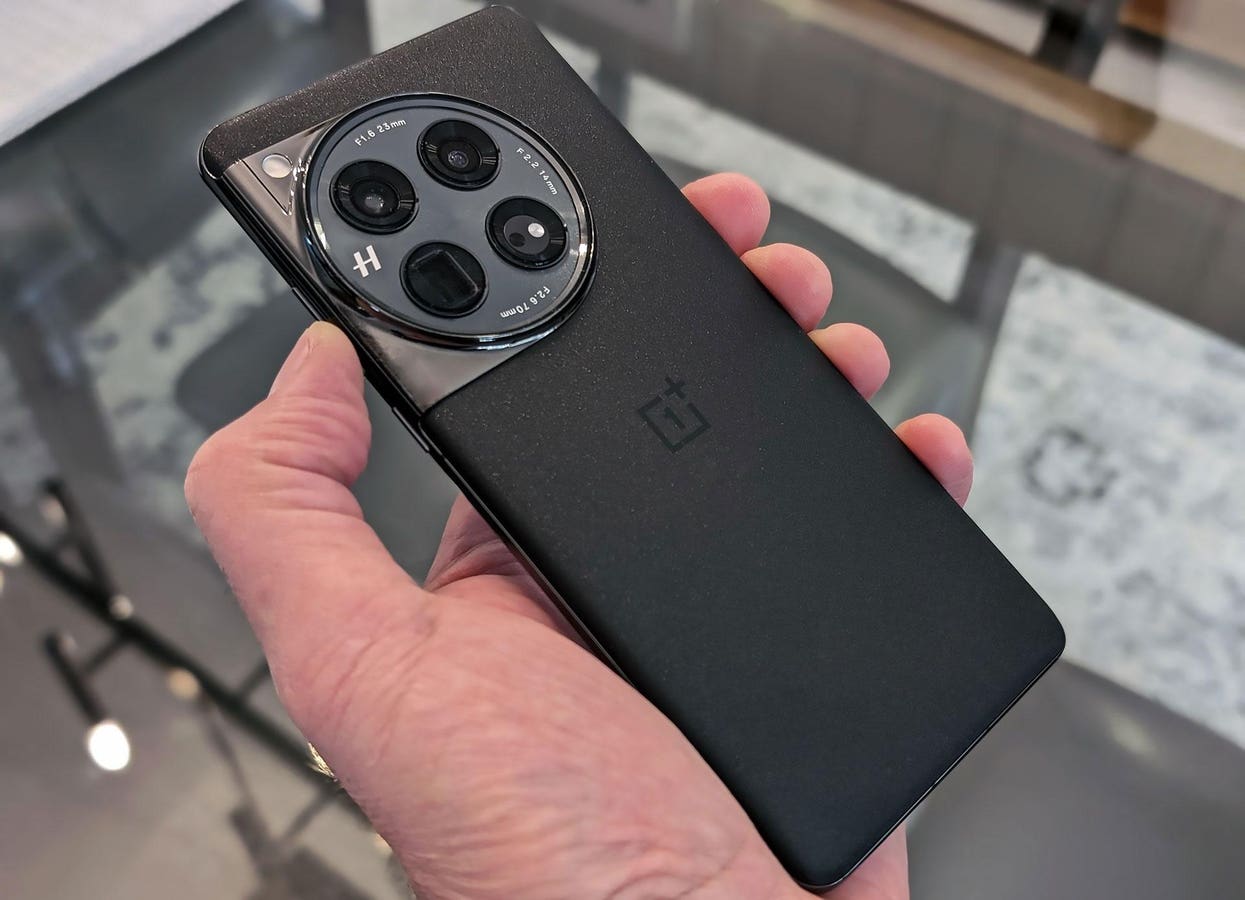Last month, value-oriented Android smartphone OEM OnePlus released a new addition to its top-of-the-line series of handsets, dubbed the OnePlus 12. In its 12th incarnation, and true to form, this device brings a lot of value and features for less. The new Snapdragon 8 Gen 3 powered Android phone is also very much in keeping with the company’s long-time motto of “never settle,” that put it on the map with smartphone enthusiasts years ago. Weighing in at just $799 for the 16GB of RAM and 512GB of storage variant, this new device competes with the likes of Samsung’s Galaxy S24 Ultra, as well as Apple’s iPhone 15 Pro Max, which retail for $1200 and $1400, respectively in similar storage but slightly lower memory configurations. While I’m not going to delve into a head-to-head compare here, the net-net is you get a lot for your money with this new OnePlus Phone versus its direct competition. I did, however, also want to share my experience with this device, having used it as my daily driver for over a month now.
OnePlus 12 – As Close To No Compromise As It Gets Currently
Design-wise, the OnePlus 12 is a fairly compact, though larger format device, with a gorgeous 6.82-inch Quad HD+ (3168 × 1440, 510ppi, 10-bit) LTPO AMOLED display, 1-120Hz variable refresh rate, and support for both HDR10+ and Dolby Vision. This is one of the best phone displays I’ve set my eyes in a long time. It has 4500 nits of brightness that can be seen in daylight without issue, except for occasional glare from the glossy Gorilla glass-strapped display. The display has a slight waterfall edge on the front, and yes that wonderful ring/vibrate/DND slider switch is back, on the left edge of the phone, with an impressive, round, Hasselblad camera array on the back (pictured above), the performance of which I’ll cover a bit later.
Delving a bit more into the specs, again the OnePlus 12 is powered by Qualcomm’s new Snapdragon 8 Gen 3 and it’s arguably the fastest, most efficient Android phone platform on the market currently, with support for both mmWave and Sub-6 5G connectivity, as well as a 30% faster GPU, 20% faster CPU and over 40% faster Neural Processing Unit for AI workloads, versus the previous gen Snapdragon 8 Gen 2. Supported by either 12GB or 16GB of LPDDR5X RAM (16GB on the $799 variant) and up to 512GB of UFS 4.0 Flash storage, this phone screams in the benchmarks. Here’s a quick tease from our team at HotHardware…
As you can see from the benchmark quick-takes above, this is one of the fastest Android smartphones on the market currently, and it holds its own with an iPhone 15 as well, even beating it in the gaming and graphics-focused 3DMark Wild Life test. There’s of course a bit of throttling on the device, with extended heavy use in gaming, for example. However, there aren’t many phones (including iPhones) on the market these days that don’t throttle a bit, save for perhaps beefier high-end gaming phones.
In terms of cellular connectivity, though the OnePlus 12 itself doesn’t support mmWave 5G (other Snapdragon 8 Gen 3 phones like Galaxy S24 Ultra do), it does support Sub-6 5G bands and performance here is impressive to be sure as well. Take a look…
There are probably more than a few Forbes readers that can’t get those kinds of speeds on their home broadband internet service, never mind a cellular wireless network. I tested the OnePlus 12 on a 5G Google Fi connection, which is strapped to T-Mobile here in the New England area. As you can see, the 5G rollout has finally come to fruition, delivering significantly better experiences and blazing speeds, though T-Mobile is still making big strides on Sub-6 5G upload bandwidth. On a side note, 5G modem technology is not trivial, as attested to by Apple, which continues to license and purchase Qualcomm’s Snapdragon 5G modem technology and will likely do so for the foreseeable future. Regardless, I’ll take 1.3Gbps download speeds all day, thanks, and I only get around 900Mbps downloads on my home office fiber connection.
OnePlus 12 Camera Experience And Sample Shots
Moving on to camera performance, the OnePlus 12 is equipped with a high-end camera array consisting of three powerful shooters: a 50MP f/1.6 main sensor (Sony LYT-808) with omni-directional Phase Detection Auto Focus and Optical Image Stabilization, a 48MP f/2.2 114-degree ultrawide (Sony IMX581) camera with Auto Focus, and a 64MP f/2.6 3x periscope telephoto lens (OmniVision OV64B) also with PDAF and OIS.
Shooting modes for the OnePlus 12 include the usual standard mode, as well as Portrait, Night mode, up to 64MP high-res shooting, Action, and Panorama modes, among others. There’s a new Master mode for all the rear cameras, which is a Pro mode of sorts with extra controls for saturation, contrast, sharpness, etc. OnePlus also has a RAW+ option that brings RAW shooting and computational photography together for some impressive results, if you’re the type that likes to work with images in a post-processing app for a bit more polish. Regardless, here are some quick results I was able to pull from the OnePlus 12, utilizing its standard shooter, ultrawide and zoomed telephoto shooters.
I’ve tried to demo a myriad of mainstream shot use cases here, though admittedly I’m still investigating low light results. Regardless, the OnePlus 12 handles some difficult shot types well, like the 3X zoom Blue Jay on the birdfeeder shot and the difficult Portrait mode shot of the orchid. Here, this new Android value-oriented flagship performed very well, isolating the flower from its background environment perfectly. However this challenging Portrait mode shot did take a couple of tries to get it perfect, with just a little coaxing.
Finally, as you can see in the New York city and Echo Lake shots, the ultra-wide mode of the OnePlus 12 can deliver impressive results. Our team at HotHardware considers the OnePlus 12’s computational photography chops to be right up there with some of the best on the market, possibly exceeding the Samsung Galaxy S24 in certain scenarios, and holding its own versus Google’s Pixel 8 Pro.
OnePlus 12 Battery Life – Still Not Settling
Battery life is exceedingly good with the OnePlus 12, though this is almost to be expected with its capacious 5400 mAh battery on board that is comprised of two 2700 mAh cells for ridiculously fast charging.
In our PCMark Work 3.0 battery test, the OnePlus 12 lasted 1227 minutes, or a full 20 hours and 27 minutes of always on up-time, with mixed workloads like video streaming, productivity and photo editing. In short, even heavy users will rarely have an issue with this phone running down over a full day’s use. And if you do, this phone delivers virtually unmatched charging speeds for phones in this price bracket.
Did The OnePlus 12 Make The Cut As My Daily Driver?
In Fact, the OnePlus 12’s 80 Watt Super VOOC charging and 50 Watt AirVOOC wireless charging is much faster than any big name brand phone in the US, including iPhone 15, Samsung Galaxy devices or Google’s Pixel line.
The OnePlus 12 lacks only a couple minor features, in my opinion. First would be its IP65 water and dust resistance rating, which isn’t as good as the IP68 levels of resistance that are common on other flagship phones. However, it can withstand low pressure water jets and splashes from any direction, at this spec. If you’re the type to let your phone drop in the drink, you might have issues but that’s like a rare few out there, I’d postulate. This phone also lacks Millimeter Wave 5G connectivity, though it’s supported by Qualcomm’s Snapdragon 8 Gen 3 platform that powers the OnePlus 12. This isn’t a showstopper for me either because longer reach, with better coverage, Sub-6 5G connectivity is on tap here. As you can see from my speed test results in a rather rural area of New England, this phone can still bring the bandwidth.
Software-wise, the OnePlus 12 and its Snapdragon 8 Gen 3 powerplant is driven by Android 14 and a very light skinning of OnePlus OxygenOS 14. This is software setup is one of the least cluttered, closest to stock Android experiences you can get these days, short of Google Pixel devices. All in, I think the vast majority of Android user will enjoy the experiential side of this device, and perhaps even a few daring iPhone folks as well.
I have the honor of getting my hands on many great smartphones in my line of work. Previously I was running a Google Pixel 8 Pro, and have had hands-on time with many more devices. Though the OnePlus 12 isn’t perfect, it’s darn close to perfect for my use cases. I love the convenience of wireless charging, like to run with a larger format device with a killer display, and almost above all else I want all around performance (both general purpose and camera) with respectable battery life.
So the bottom line is the new OnePlus 12 definitely made the cut as my daily driver smartphone of choice, and I do have many to choose from. This reasonably priced, $799 (unlocked) Android flagship delivers on all fronts. And yes, we’re back to truly “never settling” with OnePlus. The OnePlus 12 checks virtually all the boxes, but at hundreds less than the competition.
Read the full article here





